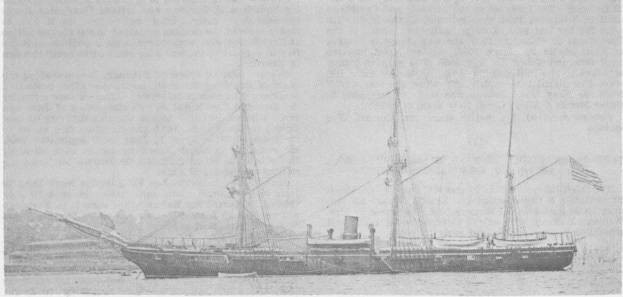Juniata I (Sloop-of-War)

A river in Pennsylvania emptying into the Susquehanna.
I
The first Juniata was a steam sloop of war launched at Philadelphia Navy Yard 20 March 1862; sponsored by Miss Angela Turner; and commissioned there 4 December, Comdr. John M. B. Glitz in command.
Scheduled for service in the West Indies, Juniata was temporarily assigned to the North Atlantic Blockading Squadron and stationed at Norfolk, where her guns could help defend the area while machinery defects were corrected at the Navy Yard. She departed Hampton Roads for the West Indies 26 April 1863 and 4 days later captured schooner Harvest bound for Nassau, New Providence, with a cargo of cotton. She joined the West Indies Squadron at Havana 5 May. She captured English steamer Victor about 8 miles off Morro Castle, Cuba, 28 May and took schooner Fashion 13 June loaded with chemicals critically needed by the Confederacy. The next day she captured English schooner Elizabeth, and Don Jose 2 July.
Juniata continued to cruise in the West Indies convoying California-bound ships to safe waters and alertly watching for signs of Confederate cruisers and blockade runners until she sail for New York 24 November, arriving there 2 December. Under repairs at Philadelphia during the first half of 1864, Juniata departed 12 August in search of Confederate cruiser Tallahassee reported off Sandy Hook, N.J. Five days later she anchored in Hampton Roads and joined the North Atlantic Blockading Squadron. She operated out of Hampton Roads until steaming to Wilmington early in December in preparation for forthcoming offensive operations against that powerful stronghold and blockade running center. She was in the thick of the fighting during the first attack on Fort Fisher, closing Southern batteries to get in position for effective bombardment. Her daring upon this occasion, which cost her 2 officers and 3 men killed and 11 men wounded, was again displayed during the second attack on Fort Fisher between 13 and 15 January 1865. Five more of her men were killed and 10 wounded in this assault which wrestled Wilmington from Southern hands, sealing off the Confederacy from effective foreign aid.
Juniata was transferred to the South Atlantic Blockading Squadron 18 January and arrived Charleston Roads the next day. After a brief visit to Port Royal, S.C.. to repair some of the damage sustained in the furious action at Fort Fisher, she participated in the expedition to Bull's Bay in support of General Sherman's drive north through 17 February.
Juniata received orders 23 February to cruise along the coast of Brazil as far south as Buenos Aires protecting American citizens and interests. After extensive repairs she departed Port Royal on this assignment 17 June and arrived Bahia, Brazil, 8 August bringing that city its new United States consul. With the exception of a cruise to the coast of Africa from 12 June to 30 September 1866, she remained in South American waters until 30 April 1867 when she sailed from Rio de Janeiro for home, arriving Philadelphia 24 June.
Juniata decommissioned at Philadelphia Navy Yard 29 June and remained there until recommissioned 19 July 1869 and departed for Europe. She served, in European waters until 18 June 1872 when she sailed for the United States arriving Boston Navy Yard 29 June. She decommissioned 10 July.
Juniata recommissioned 10 February 1873 serving on the northeast coast until 26 June when she got underway for St. John's, New Foundland en route to the west coast of Greenland to assist Tigress in her quest for survivors of Polaris which had come to grief exploring the Arctic. Juniata steamed as far north as Upernavik some 250 miles above Godhaven, Greenland, where she supplied Tigress. She returned to New York 1 November 1873.
After a cruise to the Caribbean, Juniata sailed for the European Station 6 May 1874 and remained on duty there until she returned to the United States, arriving Baltimore 6 February 1876. She decommissioned at Norfolk 1 September.
Juniata recommissioned at New York Navy Yard 30 October 1882, Comdr. George Dewey in command, and departed on a voyage which took her around the World through the Strait of Gibraltar, the Suez Canal, to Bombay, Batavia, Singapore, and Hong Kong, among her many ports of call. She returned to New York 10 December 1885 and operated from that port until she sailed for the Pacific 16 August 1886. She again returned to New York 4 February 1889 and decommissioned 28 February. Juniata was sold at Navy Yard, Portsmouth, N.H., 25 March 1891 to Herbert H. Ives.


